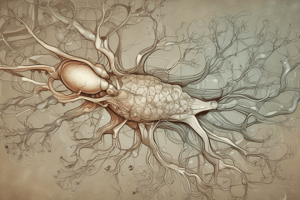Podcast
Questions and Answers
What are the three main components of homeostatic control mechanisms?
What are the three main components of homeostatic control mechanisms?
Receptor, Control Center, and Effector.
Describe the role of receptors in homeostatic control mechanisms.
Describe the role of receptors in homeostatic control mechanisms.
Receptors provide information about stimuli in the internal environment.
Identify one positive and one negative feedback mechanism in homeostasis.
Identify one positive and one negative feedback mechanism in homeostasis.
Positive feedback enhances a process, while negative feedback reduces or corrects a deviation.
What types of receptors are taste and smell classified as?
What types of receptors are taste and smell classified as?
List the four basic tastes recognized and the additional one considered a fifth taste.
List the four basic tastes recognized and the additional one considered a fifth taste.
Flashcards
Homeostasis
Homeostasis
The body's ability to maintain a stable internal environment despite external changes.
Negative feedback
Negative feedback
A mechanism that counteracts changes, bringing the body back to its set point.
Positive feedback
Positive feedback
A mechanism that amplifies changes, pushing the body further from its set point.
Taste (Gustation)
Taste (Gustation)
Signup and view all the flashcards
Umami
Umami
Signup and view all the flashcards
Study Notes
Homeostatic Control Mechanisms
- Homeostatic control mechanisms monitor the internal environment and correct variations that are outside of limit.
- It has three parts:
- Receptor: provides information about stimuli
- Control Center: tells what the set point should be
- Effector: elicits responses to change internal environment conditions
- Two types of mechanisms:
- Negative feedback mechanisms
- Positive feedback mechanisms
Special Sensory Receptors
- Receptors are not free nerve endings of sensory neurons.
- They are specialized receptor cells.
- They are localized in the head region.
- These receptors include taste, smell, sight, hearing, and balance.
Taste (Gustation)
- Taste, or gustation, is mediated by taste buds in taste papillae on the tongue.
- Taste buds have a standardized pattern.
- Taste receptors occur in taste buds.
- Most taste receptors are located on the surface of the tongue in the papillae.
- Four basic tastes: sweet, sour, salty, and bitter
- A fifth taste, umami, is perceived as "deliciousness"
- There is no structural difference among taste buds.
- Taste receptors are chemoreceptors which respond to chemicals.
Studying That Suits You
Use AI to generate personalized quizzes and flashcards to suit your learning preferences.
Description
Explore the fascinating concepts of homeostatic control mechanisms and special sensory receptors. This quiz covers the roles of receptors, control centers, and effectors in maintaining internal balance, as well as the structure and function of taste and other specialized senses. Test your knowledge on these essential physiological processes.




